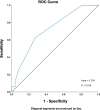The prognostic value of point-of-care blood glucose and lactate in canine and feline pyothorax: a retrospective analysis
- PMID: 40417373
- PMCID: PMC12100753
- DOI: 10.3389/fvets.2025.1581701
The prognostic value of point-of-care blood glucose and lactate in canine and feline pyothorax: a retrospective analysis
Abstract
Introduction: Blood lactate and glucose are recognized as prognostic markers in various diseases in human and animals, yet studies evaluating their prognostic utility in canine and feline pyothorax are limited. This study aimed to investigate the prognostic utility of point-of-care (POC) lactate and glucose measurements, and identify clinical factors associated with survival in dogs and cats with pyothorax.
Methods: A database search identified canine and feline pyothorax cases presenting to Auburn University between 2013 and 2023. Forty-three dogs and eight cats diagnosed with pyothorax were retrospectively enrolled. Baseline characteristics, clinicopathological data, and diagnostic findings were obtained from the medical records. POC blood glucose and lactate, recorded on admission and the following morning were documented, and lactate delta and clearance were calculated. Data on treatment was also collected. Additional outcome measures included survival and duration of hospitalization.
Results: In dogs, non-survivors had significantly higher POC lactate concentrations on admission compared to survivors (3.4 mmol/L vs. 2.0 mmol/L, p = 0.023). Band neutrophil count was associated with in-hospital mortality at a univariable level (p = 0.03, OR 1.4). Stepwise Cox regression showed total solids and lactate concentration on admission as independent predictors of outcome. The area under the curve (AUC; 95% CI) for predicting in-hospital mortality based on lactate was 0.724 (0.568-0.879).
Conclusion: In dogs with pyothorax, admission POC blood lactate concentration may serve as valuable prognostic tool to guide clinical management decisions, and an increased band neutrophil count is associated with poorer outcomes. Further large-scale studies are needed to confirm these findings.
Keywords: glucose; hyperlactatemia; lactate; point-of-care; prognostic; pyothorax.
Copyright © 2025 Zhang and Grobman.
Conflict of interest statement
The authors declare that the research was conducted in the absence of any commercial or financial relationships that could be construed as a potential conflict of interest.
Figures



Similar articles
-
Retrospective evaluation of the prognostic utility of plasma lactate concentration and serial lactate measurements in dogs and cats presented to the emergency room (January 2012 - December 2016): 4863 cases.J Vet Emerg Crit Care (San Antonio). 2022 Jan;32(1):42-49. doi: 10.1111/vec.13106. Epub 2021 Aug 3. J Vet Emerg Crit Care (San Antonio). 2022. PMID: 34343401
-
Retrospective evaluation of the prognostic utility of plasma lactate concentration, base deficit, pH, and anion gap in canine and feline emergency patients.J Vet Emerg Crit Care (San Antonio). 2018 Jan;28(1):54-61. doi: 10.1111/vec.12676. Epub 2017 Nov 22. J Vet Emerg Crit Care (San Antonio). 2018. PMID: 29165910
-
The prognostic value of admission point-of-care testing and modified Glasgow Coma Scale score in dogs and cats with traumatic brain injuries (2007-2010): 212 cases.J Vet Emerg Crit Care (San Antonio). 2022 Jan;32(1):75-82. doi: 10.1111/vec.13108. Epub 2021 Aug 25. J Vet Emerg Crit Care (San Antonio). 2022. PMID: 34432934
-
A clinical review of the pathophysiology, diagnosis, and treatment of pyothorax in dogs and cats.J Vet Emerg Crit Care (San Antonio). 2015 Jan-Feb;25(1):113-29. doi: 10.1111/vec.12274. Epub 2015 Jan 13. J Vet Emerg Crit Care (San Antonio). 2015. PMID: 25582193 Review.
-
Clinical use of plasma lactate concentration. Part 2: Prognostic and diagnostic utility and the clinical management of hyperlactatemia.J Vet Emerg Crit Care (San Antonio). 2018 Mar;28(2):106-121. doi: 10.1111/vec.12706. J Vet Emerg Crit Care (San Antonio). 2018. PMID: 29533517 Review.
References
-
- Gorris F, Faut S, Daminet S, De Rooster H, Saunders J, Paepe D. Pyothorax in cats and dogs. Vlaams Diergeneeskundig Tijdschrift. (2017) 86:183–97. doi: 10.21825/vdt.v86i3.16288 - DOI
LinkOut - more resources
Full Text Sources
Miscellaneous

